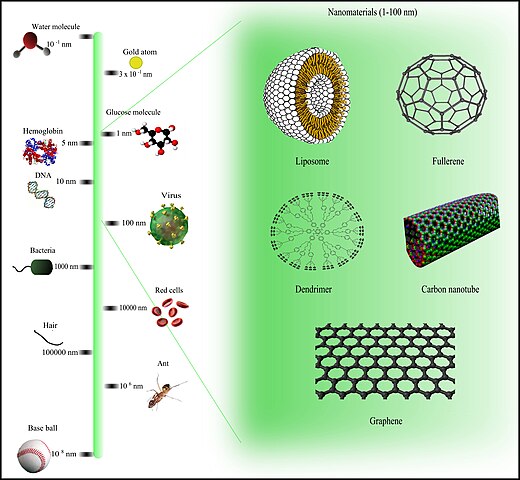Nanotechnology, the manipulation of matter at the nanoscale (typically 1 to 100 nanometers), has led to a myriad of exciting applications across various fields. Here are some notable and promising applications of nanotechnology:
1. Medicine and Healthcare:
- Drug Delivery Systems: Nanoparticles can be engineered to deliver drugs directly to specific cells or tissues, improving targeted therapy and minimizing side effects.
- Diagnostic Imaging: Nanoparticles can enhance contrast in medical imaging techniques, such as magnetic resonance imaging (MRI) and computed tomography (CT), allowing for more accurate diagnosis.
- Cancer Treatment: Nanoparticles are being developed for targeted cancer treatment, including hyperthermia, photodynamic therapy, and the delivery of anticancer drugs directly to tumor cells.
2. Electronics and Computing:
- Nanoelectronics: The use of nanoscale materials and structures in electronics has led to the development of faster, smaller, and more efficient electronic devices.
- Quantum Dots: Nanoscale semiconductor particles known as quantum dots have applications in displays, solar cells, and medical imaging due to their unique optical and electronic properties.
- Nanowires and Nanotubes: These nanostructures are explored for their potential in electronic components, including transistors and interconnects, as well as in flexible and transparent electronics.
3. Energy:
- Solar Cells: Nanotechnology is used to enhance the efficiency of solar cells by improving light absorption and electron transport properties of materials.

- Energy Storage: Nanomaterials, such as nanowires and nanotubes, are investigated for their potential in high-capacity batteries and supercapacitors for energy storage.
- Catalysis: Nanocatalysts enable more efficient chemical reactions, contributing to cleaner energy production and environmental sustainability.
4. Materials Science:
- Nanocomposites: Adding nanoparticles to materials can enhance their mechanical, thermal, and electrical properties. This has applications in manufacturing stronger and lighter materials for various industries.
- Self-Healing Materials: Nanotechnology contributes to the development of materials that can repair themselves, leading to more durable and long-lasting products.
- Water Purification: Nanomaterials are used in water purification technologies, such as nanofilters and nanomembranes, to remove contaminants at the molecular level.
5. Environmental Monitoring:
- Nanosensors: Nanoscale sensors can detect pollutants, pathogens, and other environmental factors with high sensitivity, providing real-time monitoring for improved environmental management.
- Air and Water Quality Monitoring: Nanotechnology is applied in the development of sensors for monitoring air and water quality, helping to identify and address environmental pollution.
6. Textiles and Fabrics:
- Nanotextiles: Incorporating nanoparticles into fabrics can enhance their properties, providing features such as stain resistance, water repellency, and antibacterial properties.
- Smart Fabrics: Nanotechnology contributes to the development of smart fabrics with capabilities like moisture sensing, thermoregulation, and even integration with electronic devices.
7. Food and Agriculture:
- Nanopesticides: Nanoparticles can be used in agriculture for targeted delivery of pesticides, reducing environmental impact and improving efficiency.
- Food Packaging: Nanomaterials are employed in food packaging to improve shelf life, prevent spoilage, and provide sensors for real-time monitoring of food quality.
8. Space Exploration:
- Nanomaterials in Spacecraft: Lightweight and strong nanomaterials are utilized in the construction of spacecraft, contributing to the development of lighter and more efficient vehicles for space exploration.
- Nanosatellites: Miniaturized satellites, or nanosatellites, leverage nanotechnology to perform various space missions, including Earth observation, communication, and scientific research.
9. Personal Care Products:
- Nanocosmetics: Nanotechnology is used in cosmetics to improve the delivery of active ingredients, enhance product performance, and create products with better texture and appearance.
- Sunscreen: Nanoparticles, such as zinc oxide and titanium dioxide, are used in sunscreens to provide transparent and effective UV protection.
10. Biotechnology and Biomedical Engineering:
- Nanobiosensors: These sensors enable the detection of biomolecules at the nanoscale, supporting applications in medical diagnostics and monitoring.
- Tissue Engineering: Nanotechnology is applied in the field of tissue engineering to create nanomaterial scaffolds for the regeneration of tissues and organs.
- Nanomedicine: Nanoparticles are used for drug delivery, imaging, and diagnostics in medicine, allowing for more targeted and personalized treatment approaches.
These applications represent just a glimpse of the vast and evolving landscape of nanotechnology. As research and development continue, nanotechnology is likely to play an increasingly significant role in addressing global challenges and advancing various scientific and technological domains.









